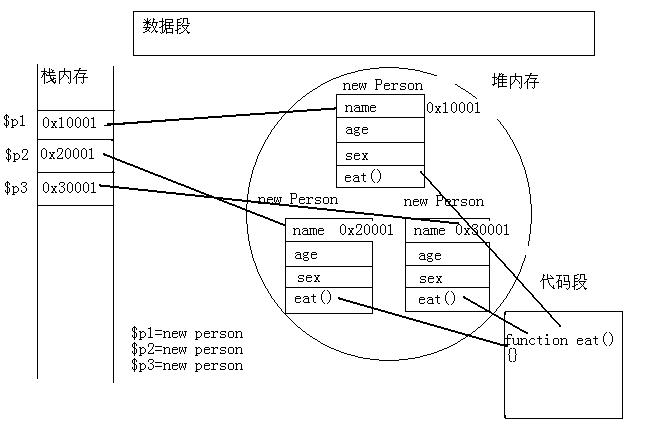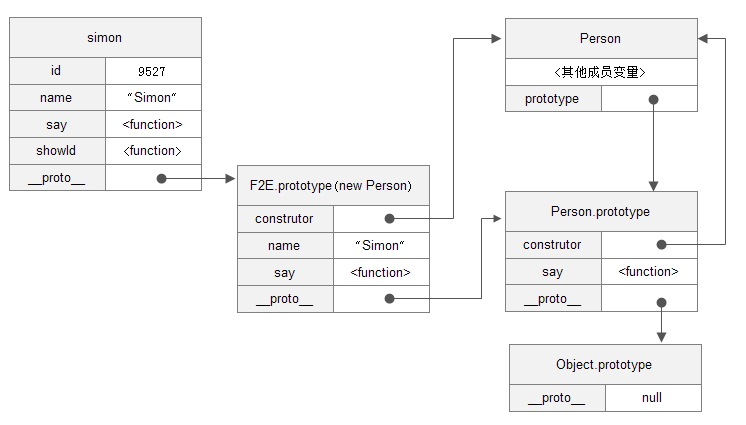js的2种继承方式详解
js中继承可以分为两种:对象冒充和原型链方式
一、对象冒充包括三种:临时属性方式、call()及apply()方式
1.临时属性方式
function Person(name){
this.name = name;
this.say = function(){
alert('My name is '+this.name);
}
}
function F2E(name,id){
this.temp = Person;
this.temp(name);
delete this.temp;
this.id = id;
this.showId = function(){
alert('Good morning,Sir,My work number is '+this.id);
}
}
var simon = new F2E('Simon',9527);
simon.say();
simon.showId();
2.call()/apply()方式
实质上是改变了this指针的指向
function Person(name){
this.name = name;
this.say = function(){
alert('My name is '+this.name);
}
}
function F2E(name,id){
Person.call(this,name); //apply()方式改成Person.apply(this,new Array(name));
this.id = id;
this.showId = function(){
alert('Good morning,Sir,My work number is '+this.id);
}
}
var simon = new F2E('Simon',9527);
simon.say();
simon.showId();
缺点:先来看这么一张内存分配图:
 |
在OO概念中,new实例化后,对象就在堆内存中形成了自己的空间,值得注意的是,这个代码段。而成员方法就是存在这个代码段的,并且方法是共用的。问题就在这里,通过对象冒充方式继承时,所有的成员方法都是指向this的,也就是说new之后,每个实例将都会拥有这个成员方法,并不是共用的,这就造成了大量的内存浪费。并且通过对象冒充的方式,无法继承通过prototype方式定义的变量和方法,如以下代码将会出错:
function Person(name){
this.name = name;
this.say = function(){
alert('My name is '+this.name);
}
}
Person.prototype.age = 20;
Person.prototype.sayAge = function(){alert('My age is '+this.age)};
function F2E(name,id){
Person.apply(this,new Array(name));
this.id = id;
this.showId = function(){
alert('Good morning,Sir,My work number is '+this.id);
}
}
var simon = new F2E('Simon',9527);
simon.sayAge(); //提示TypeError: simon.sayAge is not a function
二、原型链方式
function Person(){
this.name = 'Simon';
}
Person.prototype.say = function(){
alert('My name is '+this.name);
}
function F2E(id){
this.id = id;
this.showId = function(){
alert('Good morning,Sir,My work number is '+this.id);
}
}
F2E.prototype = new Person();
var simon = new F2E(9527);
simon.say();
simon.showId();
alert(simon.hasOwnProperty('id')); //检查是否为自身属性
接下来按照上面的例子来理解以下js原型链概念:
 |
原型链可以理解成:js中每个对象均有一个隐藏的__proto__属性,一个实例化对象的__proto__属性指向其类的prototype方法,而这个prototype方法又可以被赋值成另一个实例化对象,这个对象的__proto__又需要指向其类,由此形成一条链,也就是前面代码中的
F2E.prototype = new Person()
这句是关键。js对象在读取某个属性时,会先查找自身属性,没有则再去依次查找原型链上对象的属性。也就是说原型链的方法是可以共用的,这样就解决了对象冒充浪费内存的缺点。
下面再来说缺点:
缺点显而易见,原型链方式继承,就是实例化子类时不能将参数传给父类,也就是为什么这个例子中function Person()没有参数,而是直接写成了this.name=”Simon”的原因。下面的代码将不能达到预期的效果:
function Person(name){
this.name = name;
}
Person.prototype.say = function(){
alert('My name is '+this.name);
}
function F2E(name,id){
this.id = id;
this.showId = function(){
alert('Good morning,Sir,My work number is '+this.id);
}
}
F2E.prototype = new Person();
var simon = new F2E("Simon",9527);
simon.say();
simon.showId();
function Person(name){
this.name = name;
}
Person.prototype.say = function(){
alert('My name is '+this.name);
}
function F2E(name,id){
this.id = id;
this.showId = function(){
alert('Good morning,Sir,My work number is '+this.id);
}
}
F2E.prototype = new Person(); //此处无法进行传值,this.name或者name都不行,直接写F2E.prototype = new Person('wood')是可以的,但是这样的话simon.say()就变成了My name is wood
var simon = new F2E("Simon",9527);
simon.say(); //弹出 My name is undefined
simon.showId();
最后,总结一下自认为较好的继承实现方式,成员变量采用对象冒充方式,成员方法采用原型链方式,代码如下:
function Person(name){
this.name = name;
}
Person.prototype.say = function(){
alert('My name is '+this.name);
}
function F2E(name,id){
Person.call(this,name);
this.id = id;
}
F2E.prototype = new Person();
//此处注意一个细节,showId不能写在F2E.prototype = new Person();前面
F2E.prototype.showId = function(){
alert('Good morning,Sir,My work number is '+this.id);
}
var simon = new F2E("Simon",9527);
simon.say();
simon.showId();
- 上一篇:JavaScript的21条基本知识点
- 下一篇:Seajs的学习笔记






